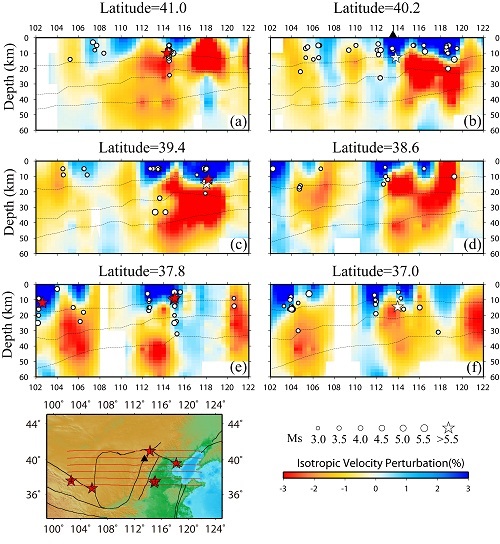Crustal and uppermost mantle structure and seismotectonics of North China CratonUpdate time:10 14, 2013
Vice Professor WANG Jian and his team determine a 3-D P-wave anisotropic tomography of the crust and uppermost mantle beneath North China Craton (NCC) using 107,976 P-wave arrival times from 16,073 local earthquakes recorded by 380 seismic stations. Their results show significant lateral heterogeneities beneath NCC. The lower crust and uppermost mantle beneath the North China Basin show widespread low-velocity anomalies which may reflect high-temperature materials caused by the late Mesozoic basaltic magmatism in the NCC. Low-velocity anomalies also exist beneath the Trans-North China Orogen, which may reflect asthenospheric upwelling since late Mesozoic. Large crustal earthquakes generally occurred in high-velocity zones in the upper to middle crust, while low-velocity and high-conductivity anomalies that may represent fluid-filled, fractured rock matrices exist in the lower crust to the uppermost mantle under the source zones of the large earthquakes. The crustal fluids may lead to the weakening of the seismogenic layer in the upper and middle crust and hence cause the large crustal earthquakes. The NW–SE P-wave fast velocity directions seem to be dominant in the uppermost mantle under the central parts of eastern NCC, suggesting that these mantle minerals were possibly regenerated but keep the original fossil anisotropy formed before the new lithospheric mantle was produced during the Mesozoic to Cenozoic.
Fig. 1. Vertical cross sections of isotropic velocity images along six profiles. (Image by WANG)
Fig. 2. The obtained P-wave anisotropic images at 45Km depth layer. (Image by WANG) Wang et al. Crustal and uppermost mantle structure and seismotectonics of North China Craton. Tectonophysics, 2013, 582: 177-187(Download Here)
|
Contact
Related Articles
Reference
|
-
SIMSSecondary Ion Mass Spectrometer Laboratory
-
MC-ICPMSMultiple-collector ICPMS Laboratory
-
EM & TEMElectron Microprobe and Transmission Electron Microscope Laboratory
-
SISolid Isotope Laboratory
-
StIStable Isotope Laboratory
-
RMPARock-Mineral Preparation and Analysis
-
AAH40Ar/39Ar & (U-Th)/He Laboratory
-
EMLElectron Microscopy Laboratory
-
USCLUranium Series Chronology Laboratory
-
SASeismic Array Laboratory
-
SEELaboratory of Space Environment Exploration Laboratory
-
PGPaleomagnetism and Geochronology Laboratory
-
BioMNSFrance-China Bio-mineralization and Nano-structure Laboratory

 Print
Print Close
Close

